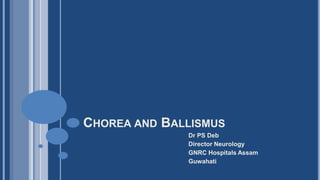
Chorea and ballismus
- 1. CHOREA AND BALLISMUS Dr PS Deb Director Neurology GNRC Hospitals Assam Guwahati
- 2. CHOREA State of excessive, spontaneous movement, irregularly timed, non repetitive, randomly distributed and abnormal in character. It may very in severity from restlessness with mild intermittent exaggeration of gesture and expression, fidgeting movement of hands unstable, movement of hands. Unstable gait to continuous flow of disabling violent movement. Random – distribution, time, and duration
- 3. CHOREA Associated with Hypotonia – Reduced long latency reflex Motor impersistence → inability to sustain vol. movement Pronator sign Milkmaids sign Trombone tongue Hung-up reflex – Prolonged contraction of stretched muscles by late sensory provoked choric movement.
- 5. CHOREA MECHANISM - NEUROTRANSMITTER DISTURBANCE Reduced: GABA, Sub P, Ach Increased: Dopamine, NA in Striatum and pallidum, Somatostatine GABA in SN and GP due to degeneration of striatum, but gabargic drugs does not reduce chorea Dopamine Tyrosin hydroxylase enzyme in SN, chorea reduced by anti dopa drugs and by Ldopa Ach marginally reduced, choline esterase enzyme mild reduced, large striatal interneuron well maintained, Ach agonist does not improve chorea
- 6. CHOREA PATHOGENESIS PET - Histochemistry Drug effect Surgical Chorea reduced by Pallidotomy, Nigrotomy, Thalamotomy Pathological Animal Model
- 7. ELECTROPHYSIOLOGICAL Choric discharges on EMG resemble normal voluntary contraction Active inhibition of innervation Readiness potential not tested id Idea Programming Execution Discharge DischargeChorea Association Cortex Basal Ganglia Motor Cortex
- 8. MECHANISM OF CHOREA Chorea appears to be a fragments of normal movements, appearing in inappropriate circumstances and lacking any purpose They may be determined by peripheral stimuli which in ordinary circumstances would be ignored. Basal ganglia normally filter the mass of cortical input, they receive to select movement appropriate to the circumstances. Striatal damage might prevent normal suppression of unwanted motor response to external stimuli → Chorea
- 9. CAUSE OF CHOREA AND CHOREO-ATHETOSIS 1. Trauma 1. Concussion 2. Neoplasm 1. Primary brain tumor 2. Metastasis 3. CNS leukemia 3. Cerebrovascular disease 1. Epidural subdural hemorrhage 2. Hemorrhage 3. Lacunar infarct 4. AVM 5. Polycythemia 6. Migraine 4. Infection 1. Post streptococcal 2. Typhoid 3. Pertusis 4. Dyphtheria 5. Neurosyphilis 6. Tuberculosis 7. Mycoplasma 5. Viral infection 1. Exanthema 2. Encephalitis 6. Collagen vascular disease 1. MSV
- 10. CAUSE OF CHOREA AND CHOREO-ATHETOSIS CONT…. 7. Metabolic 1. Electrolyte imbalance 2. Glucose metabolic disorder 3. Endocrinal – Thyroid, Adrenal 4. Copper metabolic impairment – Wilson 5. Renal failure 6. Nutritional – thiamine, Niacin, B12 8. Intoxication 1. Alcohol 2. CO 3. Mercury 4. Manganese 5. Thallium 6. Glue sniffing 9. Drugs 1. Neurolaptics 2. Dopa agonists 3. Anti cholinergic 4. Sympathomimetics 5. Steroid, estrogen 6. Opiates 7. INH 8. Reserpine 9. Anti-histaminics 10. Tricycle antidepressants 11. Lithium 12. Metaclopromide 13. Digoxin 14. Lithium 15. Diazoxide
- 11. CAUSE OF CHOREA AND CHOREO-ATHETOSIS CONT…. 10. Hereditary 1. Aminoaciduria 2. Lipid 3. Glucose 4. Protein metabolic 5. Huntington’s chorea 6. Benign familial chorea 7. Chorea with Acanthocytosis 8. Familial inverted choreoathetosis 9. Familial striatal necrosis 10. Familial basal ganglionic calcification 11. Spinocerebellar degeneration 11. Other 1. Hallevorden spatz disease 2. Ataxia Telengectasia 3. Tuberous sclerosis 4. Stuge Weber Syndrome 5. Myoclonus epilepsy with chorea 6. Paraxysmal dystonic choreoathetosis 7. Kernicterus 8. Cerebral palsy 9. Electrical injury 10. Thalamic dementia
- 12. THERAPY Drugs Dopamine antagonist Haloperidol Tetrabenazine Pimozide Perphenazine Cholinergic drugs Lecithine → ↑ cerebral choline GABA agonist INH Sod. Valproate
- 13. SURGICAL THERAPY
- 14. BALLISM Proximal, flinging, violent, involuntary movement
- 15. MECHANISM OF BALLISMUS Surgical Pallidotomy, Nigrotomy, thalamotomy reduces ballismus Animal Substantia Nigra lesion causes hemiballismus Experimental destruction of Striata nigra no ballismus, 20% destruction → hemiballismus Striatal dopamine increased Subthalamic GABA reduced
- 16. SITE OF LESION CAUSES BALLISMUS Sbuthalamus Pallidum Substantia nigra Thalamus Post. Central gyrus Superior frontal gyrus Precentral gyrus
- 18. ETIOLOGY BALLISMUS Vascular – commonest Lacunar infarct, TIA Hemorrhage Subarachnoid hemorrhage AVM Venous angioma Tumor Secondaries Cyst Infection Tuberculloma, TBM Syphilis Metabolic Hyperglycemia Drugs Contraceptive L-dopa Truama Head injury Post surgical (Parkinson disease) Multiple sclerosis
- 19. TYPES Monoballismus Hemiballismus Paraballismus Biballismus Prognosis Variable – few days to years
- 20. TREATMENT Drug Dopamine antagonists Halloparidol Tetrabenazine Thiopropazate Pimozide Perphenazine GABAargic Sod. Valproate Benzodiazepine Diazepam Clonazepam Surgical – Pallidotomy, Nigrotomy, Thalamotomy
- 21. THANKS
